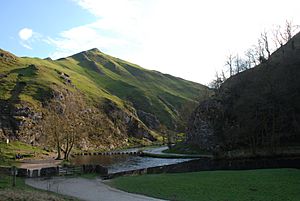James Dowdall (Chief Justice) facts for kids
Sir James Dowdall (died 1584) was an important Irish judge during the time of Queen Elizabeth I. He was even the Lord Chief Justice of Ireland for a short time. It's good to know that he was not the same person as his cousin, James Dowdall, who was a Catholic martyr.
Early Life and Legal Path
James Dowdall was born in County Louth, Ireland. He was the oldest son of Christopher Dowdall. His uncle was George Dowdall, who was the Archbishop of Armagh. James's mother, Thomasine Cusack, was the sister of Sir Thomas Cusack, who held a very important job as Lord Chancellor of Ireland. Thomas Cusack really liked James and encouraged him to become a lawyer.
The Dowdall family was originally called Dovedale. They came to Ireland from a beautiful valley in Derbyshire, England, called Dovedale. That's where they got their name! Their main family homes were in Newtown and Termonfeckin, both in County Louth. Other famous family members included Sir Robert Dowdall, who was a top judge many years before, and his son Thomas Dowdall.
James started studying law at Lincoln's Inn in London before 1549. There's even a funny record from 1554 saying he was told to shave his beard!
In 1554, Queen Mary I appointed him as the main lawyer for the Crown in Ireland, called the Principal Solicitor for Ireland. When Elizabeth I became Queen, she kept him in that job. She even gave him a special yearly payment, called an annuity, because he worked so hard in the Court of Castle Chamber. This court was like a special high court in Ireland. James mostly lived at Knock in County Louth.
Dowdall Family Life
James Dowdall married Elizabeth Thunder. Her family was well-known in Dublin and were successful merchants (people who buy and sell goods). Their unusual last name, Thunder, might have come from the French word Tonnerre. Another merchant named Francis Thunder, who received a special family symbol (a coat of arms) in 1619, was probably from the same family.
James and Elizabeth had one daughter named Ellen, who married John Barnewall. Elizabeth was still alive in 1587. At that time, a man named Sir Henry Colley sued her. He was trying to get money back for debts James Dowdall had taken on when he promised to pay for his brother Patrick's debts.
Later Career and Achievements
In 1565, James Dowdall became a judge in the Court of Queen's Bench (Ireland). Later, in 1577, he moved to the Court of Common Pleas (Ireland). He also became the Chief Justice of Munster, which meant he was the main judge in that part of Ireland. He was part of a special group, a Royal Commission, that helped set up the government in Munster.
Over the years, James was chosen for several important diplomatic jobs. This meant he represented the English Crown in talks with powerful Irish leaders like Shane O'Neill and the Earl of Desmond.
In 1583, he was made a knight and then appointed Lord Chief Justice of Ireland. This was a very high position! Sadly, he passed away the next year, in 1584.
People who knew him, like the historian Elrington Ball, said that James Dowdall was highly respected by other judges. He had a strong influence on his colleagues, especially in Ulster. Queen Elizabeth I herself thought very highly of him. She even said so in the official document (the letters patent) that appointed him.
Interestingly, the Queen's first choice for Lord Chief Justice was Sir Lucas Dillon, who was the Chief Baron of the Irish Exchequer. He was one of the Queen's favorites. However, Dillon preferred to stay in his current job. So, James Dowdall, who was recommended by the Privy Council of Ireland (a group of royal advisors) and by Dillon himself, became the clear choice. The Queen praised Dowdall for his "good service." This praise is quite special because, generally, Queen Elizabeth I didn't think much of her Irish legal officers. She often complained about their "default and inefficiency" and usually replaced them with English lawyers when a job became open.


